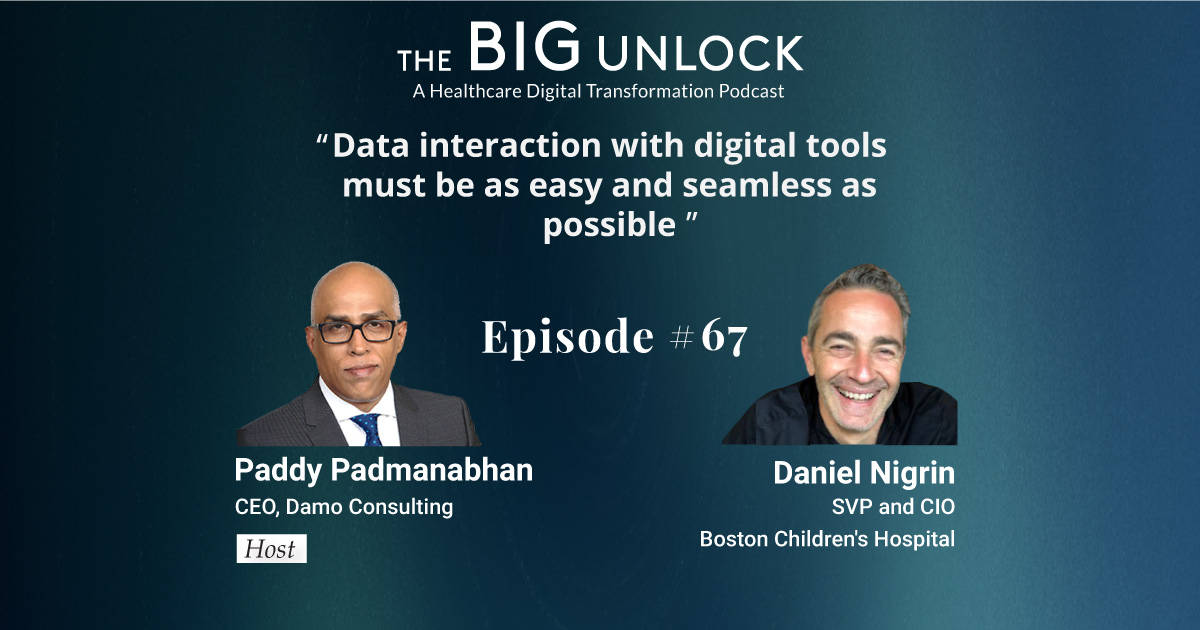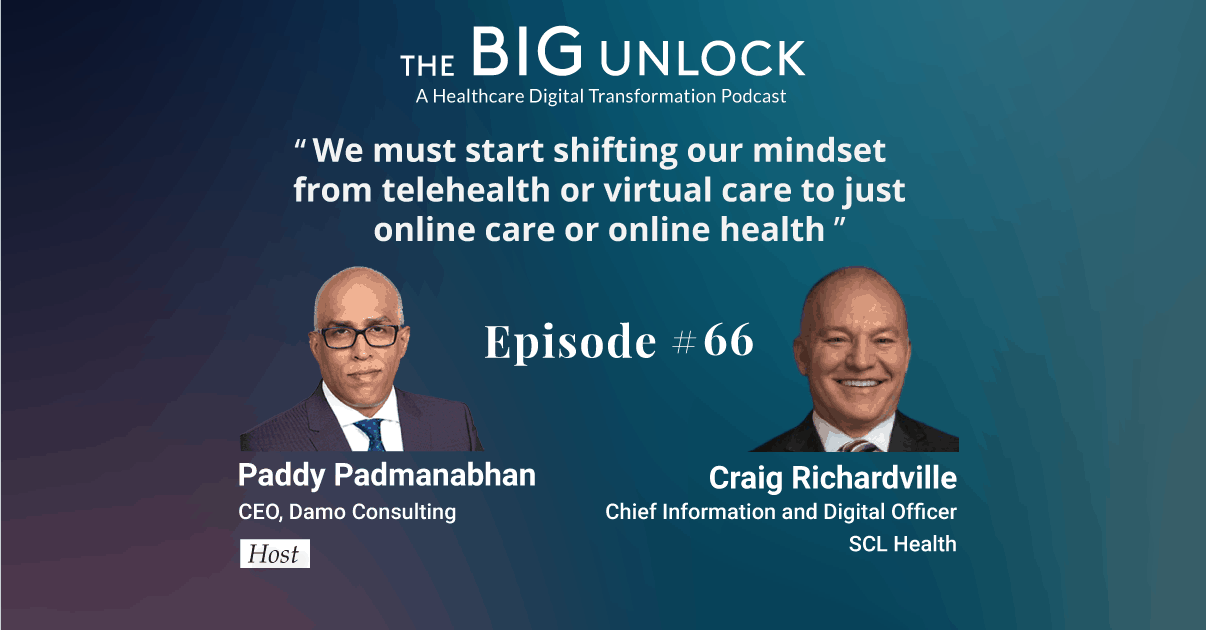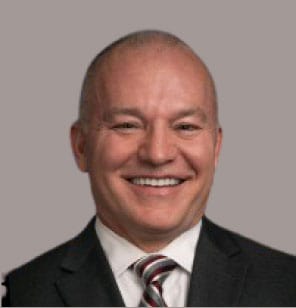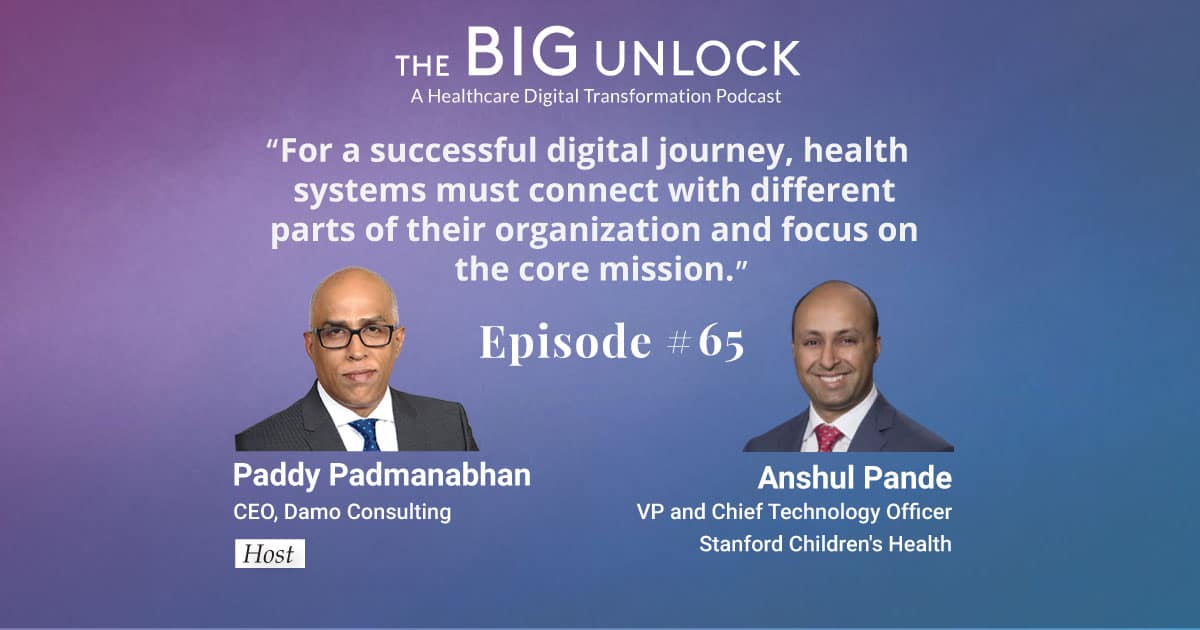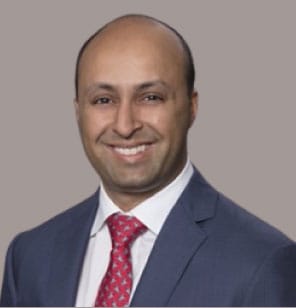Episode #67
Podcast with Daniel Nigrin, SVP and CIO,
Boston Children’s Hospital
"Data interaction with digital tools must be as easy and seamless as possible"
 Hosted by Paddy Padmanabhan
Hosted by Paddy Padmanabhan 
Share
In this episode, Daniel Nigrin discusses how digital at Boston Children’s Hospital is about transforming healthcare by improving the care experience for consumers, patients, families, and clinicians and their interaction with the health system.
Digital transformations are disruptive for healthcare organizations. It leads to new ways of doing things and enables healthcare providers to care for patients in ways they have not done before. Being a children’s hospital, Boston Children’s Hospital has to deal with the unique scenario of dealing with two sets of patient populations: the child and the parent or the caregiver. This requires a multidisciplinary approach to assessing any new technology.
Daniel talks about digital program governance at Boston Children’s and has some practical advice for startups looking to partner on innovative approaches to digital health. Daniel also discusses emerging technologies, such as voice, that will play an essential role in healthcare, both in inpatient and home settings. Take a listen.
Daniel Nigrin, SVP and CIO, Boston Children’s Hospital in conversation with Paddy Padmanabhan, CEO of Damo Consulting on the Big Unlock Podcast – “Data interaction with digital tools must be as easy and seamless as possible”
PP: [00:00:43] Hello everyone and welcome back to my podcast. This is Paddy and it is my great privilege and honor to introduce my special guest today, Daniel Nigrin, CIO of Boston Children’s Hospital. Dan, thank you so much for setting aside the time and welcome to the show.
DN: [00:01:00] Thanks so much for having me, Paddy. It’s a privilege being on here with you.
PP: [00:01:05] Thank you so much. I appreciate that. Dan, would you like to tell us a little bit about Boston Children’s and the patient populations that you serve?
DN: [00:01:14] Sure. Boston Children’s is a storied organization. We celebrated our one hundred twenty-five years anniversary a few years ago. We’re an old organization based in Boston and we are the primary teaching facility for Harvard Medical School. And as the name implies, we care for predominantly children throughout our programs. I say predominantly because we do actually have a few adult programs that tends to be for patients who’ve grown up with what used to be just childhood disorders, congenital heart problems, things such as that. And it’s telling that now-a-days care has become so good that those patients are now in their adult years. So, along with serving Boston and surrounding areas, we’re also a destination for families around the world who have specially challenging problems. Although we obviously have primary care pediatrics, we also serve patients with really difficult and challenging problems, where families are willing to travel from all over the world to come and seek care at our organization. It’s a great place and I’ve been there for a long time. This is my twenty fifth year at the organization as the CIO, which when I look back sort of boggles my mind a bit as to how that long a period of time has passed. I should probably point out that I’m actually nearing the end of my tenure at Boston Children’s. I’m heading to a new role up at MaineHealth in Portland. Maine is really a fantastic organization that serves as one of the largest systems in the northern region of the country. I am excited about that change after such a long time at Boston Children’s.
PP: [00:03:13] Congratulations on the change and congratulations on completing twenty-five years. That is quite a testament to the organization and your contributions there. So, all the very best in your new role as well.
DN: [00:03:26] Thank you so much Paddy, I really appreciate that.
PP: [00:03:29] Excellent. In this podcast, we talk about digital health, digital transformation and what I’d love to explore with you is what does digital heath mean in the context of a children’s hospital at Boston Children’s? Can you share with us the highlights of some of your two or three digital programs that are making a significant difference to your patient populations?
DN: [00:03:52] Absolutely. Well, the first challenge is having conversation with so many individuals about what digital means to them. That’s the biggest challenge, I think it’s just sort of defining it, because it really does mean so many things to different people and organizations. We’ve always viewed digital as really the transformation of healthcare, as we know today, in terms of making, not just consumers, patients and their families, but also providers and clinicians within the hospital, as comfortable and interacting with the healthcare system as it is for any of the other aspects of their lives for which there’s a digital role today. So, when you think about ordering products online, whether it be Amazon or anywhere else, when you think about ordering groceries, when you think about booking your next hair appointment, when you think about making reservations for a restaurant, all of those things are just so facile now-a-days. And are literally in the palm of your hand through your smartphone. We view digital as the transformation of healthcare to be able to achieve that level of ease of use and familiarity to people, whether that’s patients or staff. We’ve been on this journey for some time and also COVID has accelerated many of these. But even pre-COVID, we were offering many things through our portals, like many other organizations are, and we viewed that as the beginning of the consumer centric digital transformation. And those go back many years, obviously, in fact, we were one of the first organizations in the country as a pediatric organization to offer a personal health record accessible over the Web to our families that continued on. And over many years, we’ve offered things like online second opinions for families. As I mentioned, we tend to be a destination for difficult situation to solve problems for our patients. And so we’ve offered those services as well in conjunction with the patient’s primary care providers or local care providers to help augment them and give them our assessment of what’s going on with their child’s care. Most recently, and again, similar to, I’m sure, many organizations, we really had a massive increase in our telehealth adoption. We went from anywhere from 20 or 30 visits a day to over two thousand a day. I think we differ a bit from our peers. We’ve continued with that very high rate of adoption of telehealth even once things subsided a bit over the late summer and early fall with COVID. Clearly it’s ramping up again now but still we’re seeing about forty five percent or so of our ambulatory encounters and outpatient encounters being done virtually now. I’m not entirely sure why we still got that volume. But with COVID we’re pleased that we’ve got that infrastructure in place and our providers and patients both seem to have adapted well to it. Beyond that we do a lot of additional things as well. We tend to be a pretty forward leaning organization. We’re very bullish on innovation and taking innovative steps in the digital and IT realms. We’re doing things together with many smaller startups. Tonic is a vendor that we’ve recently started working with to enhance our ability to get information from our patients digitally in advance of their visits, whether virtual visits or in-person visits. So, essentially substituting for that clipboard, not just for administrative or rudimentary data, but really specialty specific data for things that providers need to know in terms of interval changes or things that have occurred since the patient’s last visit. One last example I’ll use is around voice technologies. We’re feeling that voice is going to play an important role in healthcare, whether in a inpatient setting or even in the patient’s home.
We were one of the first organizations in the country to build a HIPAA compliant Alexa skill, on Amazon’s platform. We implemented a tool that allows families with patients who underwent cardiac surgery to be able to do follow up together with us via voice, via the HIPAA compliant Alexa skill that we built. And so that was something we piloted late last year and we continue to work with that now. So, it’s just a small sampling. We’ve got many other examples, but we really do take digital seriously and think it’s where things are headed for healthcare.
PP: [00:08:59] That’s very interesting and great background. I have talked to a couple of your peers who are Chief Information Officers and Chief Technology Officers and other children’s hospitals across the country. And I’m struck by the similarities, but also by the differences in the needs of their individual patient populations. And the one thing that I didn’t know about earlier and which struck me is something very unique to children’s hospitals, it’s not just the child that is your audience. Your audience also includes their parents. So, you’re serving two different groups of individuals, one is actually receiving the care, but the other one is equally important stakeholder in care. How does that influence your choices when it comes to adopting digital technologies?
DN: [00:09:52] I absolutely think that plays an important role, Paddy. And it’s one of the unique aspects of pediatrics, obviously not unique to Boston Children’s Hospital or any pediatric organization. We always like to say that there are two patients, there’s the child, but then there’s the child’s parents or caregivers and that’s your other patient. So, it’s absolutely something that adds an interesting twist to many of our digital outreaches. For things like telehealth, in some instances, you’re dealing with a parent who is not in the same location as the child or potentially one parent is with the child. But the other parent is right at work and they want to be looped in. So, by default, we need to think about a telehealth platform that’s able to loop in more individual on the patient’s side, and so that adds an interesting twist. There’s also lots of other considerations around the privacy aspect for just basic things like let’s say we collect cell phone numbers of the patient or the family to communicate with them. If it’s a teen patient then they may be arranging for care that is sensitive and they don’t want their parents to know about, which in some states in particular is their legal right too. We’ve got to think very heavily about, whose cell phone number is this that’s in our system. And we need to be very careful around whom we communicate with and whom we don’t. So, just sort of basic things like that really do add a lot of twist to this that make things much more challenging, but fun and interesting, too, as well.
PP: [00:11:41] You are in one of the big metro markets in the country – Boston. When you look at your patient populations, you look at the technology choices in front of you especially, and you mentioned this interesting tool, which is like a digital clipboard kind of a tool. When you start looking at tools and technologies like that, especially at the front end and digital front door, if you want to call it that, how do you go about assessing these tools? What do you look for that will be different from if you were looking at the same tool from the context of a more conventional health system?
DN: [00:12:18] Because of the type of patients we’ve got and some of the unique aspects of the care that we provide, I think it’s extremely important for us and for similar types of organizations to have a multidisciplinary approach to assessing the options out there, whether it’s digital front door or any of these digital tools. To think that IT is going to be able to do this type of thing on its own is just not going to work. And it’s not just the doctors either. I’d add that we really do try and be as multidisciplinary as we can. So, we include lots of nurses in our evaluations, social workers, translators or rather interpreters. We include all of them in our assessment of new technologies that we’re evaluating for possible implementation, because each has a perspective and a need when it comes to these tools. Obviously, it depends on the particular use case that we’re talking about. But I think getting everyone’s opinion is absolutely critical in making sure that we choose wisely when we do. The other thing that we at Boston Children’s have always done is – ‘try before we buy.’ We test and pilot a lot of things. We have an innovation and digital health accelerator program. And within that group, we really do try and partner with many organizations and try to do a little proof of concept trial runs, pilot initiatives to see whether or not the technology is going to be able to scale and serve our needs. I think between those things, getting lots of eyes and assessments of the technology, as well as doing a bit of a trial before scaling it, are two important aspects that we can be sure that the choices are going to work for us.
PP: [00:14:17] I was going to ask you about how you harness the innovative technologies out there and sounds like this is a way for you to try before you buy and manage the risks or the technology risks as well as the financial risks involved in committing to some of these innovative programs and innovative technology solutions.
DN: [00:14:37] Along those lines we fully expect to have many of them fail at that pilot stage. That’s almost intentional I’d say. If we’re not failing at some of them we’re probably not extending our reach as broadly as we should.
PP: [00:14:51] I’ve heard some of my guests tell me that if you’re going to fail, fail fast and move on. So, you’re not lingering on something that’s not going to work, but you’re moving on to the next thing which is more likely to work than reducing your risks and minimizing the financial impact of these decisions as well. In that context, what is the role of enterprise, specifically, EHR systems. We’ve seen EHR systems evolve from what they were a few years ago to more of digitally enabling platforms. A lot of front end digital front door kind of functionalities are now available with your platforms like Epic and Cerner. When you look at those, firstly, what do you see as the central role of the EHR for enterprise like yours? And how do you view them in the context of digital health innovations?
DN: [00:15:46] We absolutely see EHRs as of the core repository for our patient care. There’s really no other way around it. And I should say that we look to those vendors because we’re still in a bit of a unique position at Boston Children’s, where we have both Cerner as well as Epic primarily for our rev cycle and kind of backend processes and Cerner for our clinician-facing functions. So, we do look to those platforms, first and foremost, to see what offerings they have because the last thing we want to do is start to layer additional vendors and additional technologies when our core vendors can accommodate our need. But assuming that thing that we’re after is not provided by them, we like to see EHR serve as the ultimate repository for interactions that might occur with that third-party digital tool. And we also like to see the data interaction with the digital tool be as easy and seamless as possible. So, by that I mean, let’s hope that the Cerner or Epic platform has exposed the data that’s required via APIs via FHIR. Let’s hope that the third-party vendor is utilizing those APIs and can accommodate them and in essence sort of lay on top of the hour in a way that makes it seamless for the provider. So, as much as possible to integrate into the workflows that are part and parcel of the EHR platform. So again, thinking about SMART on FHIR kinds of applications.
PP: [00:17:29] And you touched upon something that obviously is central to making this entire ecosystem of applications work seamlessly, which is the notion of integration, interoperability, if you will. And we’ve come a long way in the last few years. It used to be that there was a lot of frustration, maybe a few years ago about the lack of interoperability. But we’ve come quite a way since then. I still hear though that it is a challenge. And so, from that standpoint, and you mentioned early on that, you’ve seen the telehealth visits go up significantly since the pandemic.
And I’ve talked with health systems where they’ve had to put in telehealth platforms at short notice because they really didn’t have a telehealth program. And now they’re seeing that they are well integrated with the backend EHR systems and they’re having to go back and revisit their choices. What has been your experience with regards to the interoperability challenges and the technology choices that you’ve made? What’s your advice for your peers out there who are facing these issues?
DN: [00:18:33] Yeah, this is challenging because in theory the API push that’s occurred should have solved many of these problems. We should have data liquidity everywhere. It’s now mandated in 21st century cures and so on. But as we all know, the reality is that we’re only just starting and we’ve only got certain data elements that are exposed by the vendors. And we have many instances in which we really tried to just say, no, we’re only going to use FHIR. We’re only going to take advantage of these interoperable features that have been added. And yet we inevitably will end up recognizing that we need some data element or some aspect of the core system that’s not yet available. And so, we need to revert to things like HL7 and so on. So, I think it’s still a work in progress. I’m encouraged by the forward steps that we’ve continued to see the vendors make, as well as the third-party vendors and startup companies that are building upon those. So, I’m encouraged and I think that will eventually get there. But for now, I think we’re still in this sort of middle ground place where we’ve still got to rely a little bit on our tried and true old interfaces and previous approaches that we took. The one other thing that we’ve taken quite a bit of an advantage of, after a lot of investment over many years, is to establish an enterprise wide data warehouse that we still put the vast majority of all of our data into. Not just our clinical EHR data, but lots of other additional data, social determinants of health kinds of administrative data. And in many instances, we find that we run things, whether analytic kinds of tools or other sort of AI based kind of efforts. All are run of from that enterprise data warehouse, for which we’ve developed a data dictionary for. So, I still think there’s a purpose for that kind of thing within our organizations. And that’s also helped us quite a bit as we thought about some of these emerging tools and as we’ve tried some of them as well.
PP: [00:20:56] So are you looking to use that enterprise data warehouse now as the single source of truth, if you will, for applications that want to integrate into your system through an API interface?
DN: [00:21:10] We absolutely use the single source of truth. We tend to try and avoid using it for operational or for real time kinds of purposes. But absolutely for analytics kind of efforts, for machine learning efforts where we want to train new algorithms and so on. We are absolutely looking to our warehouse for those kinds of feeds.
PP: [00:21:32] Very interesting. So, I want to go back to the question of startups and harnessing the innovation ecosystem , if you had to give them advice, if they want to come in and be a part of your journey at Boston Children’s, would you tell them first and foremost to have a SMART on FHIR kind of an application that integrates seamlessly with the EHR system? If so, what else would you tell them if they want to start working with you? What is your advice to them?
DN: [00:22:00] I absolutely do think that gets them a good foot in the door. Being one of the places in the country that helped to establish SMART on FHIR and really push for it, that definitely endears themselves in our eyes if they come in with that out of the gate. But I’d say beyond that is they need to have a grounded background in terms of what the clinical problem is that they’re trying to solve. One thing that we detest, and that’s a strong word, but it is when we’re approached by vendors who have an interesting technology or technological approach to something. But they’ve given no thought or have no background in the real challenges that our clinical care teams face as they take care of our patients. And so, having either someone on their teams themselves or if not perhaps having spoken with organizations to get that real-world feedback, is this something that’s really going to help our clinical providers. And is it going to work in a clinical setting? Those are elements that they had to have thought about ahead of time and that their products have to address. Well, because if there’s one thing that irks me is technology for technology’s sake. I don’t like just putting in a shiny new object because it’s an interesting new technology. It’s got to be clear what clinical problem it’s solving. They need to have tailored their product with that in mind. Now all of that said, I will absolutely say that I subscribe to the classic Steve Jobs idea, which is – consumer doesn’t know what they need or what they want. And in some cases, I will say that there’s opportunity for that in healthcare. We need to have our eyes opened to new ways of doing things and to new approaches that we haven’t really ever considered before, simply because we’ve never done it that way. I do think, having said everything that I just said about knowing the clinical environment and accommodating, that there is a place in some instances where a new disruptive approach would and could work. And so, we’re open to that at the same time.
PP: [00:24:16] That’s great advice then. And I’ve heard many of your peers say the same thing, that technology for technology’s sake is really not going to cut it. And startups who listen to my podcast take note of these comments, by the way. I think this message is coming through very consistently to startups from the CEOs and others who are looking at evaluating these solutions. So, let me switch back to the digital transformation program at Boston Children’s. Can you share a little bit with us about how you govern your digital programs in terms of the org structure? Do you have a separate budget for it? How do you prioritize the initiatives?
DN: [00:25:00] Great question, Paddy. So, first and foremost, I should say our digital initiative has been marked as an enterprise wide strategic goal and has been there for the last several years now. So, this is not just an IT goal. This is not a CIO sort of dream. This is a top-level enterprise level strategic goal. And I think that’s incredibly important because many of these digital transformations are disruptive for organizations. It will lead to new ways of doing things, pushing our providers to care for patients in ways that they’ve not before. And so, without that top-level leadership being on board and willing to push in some instances, you won’t be nearly as successful as if you do have that support so that’s first and foremost. With respect to the financing, to underscore the importance of this and the fact that it’s been marked as a strategic goal. The organization has set aside strategic level funds to support our digital sets of initiatives to the tune of tens of millions of dollars. I won’t say the exact amount, but tens of millions of dollars over a multi-year period so that we don’t sell ourselves short, because I appreciate that many organizations have tried to do this. But have said we’ll just do it using your existing budgets. I don’t think that’s going to work. I think to do this properly, you really do need to make an investment with dedicated resources and a big push from an organizational perspective. So, that’s the money and that’s the top-level goals. With respect to the ‘who,’ this is clearly one of my top-level goals and strategies from the IT and the CIO perspective. But we’ve got an interesting organizational structure at Boston Children’s where we also have a Chief Innovation Officer. I affectionately refer to him as the other CIO and we really are locked arm in arm on this set of initiatives. In addition, we’ve got a Chief Digital Transformation Officer and she’s been a critical part of this digital set of efforts as well. And so, we all partnered together and we each have got our respective teams. We try and ensure that we’re going fast. And this is primarily the part that our Chief Innovation Officer is overseeing. He oversees the digital health accelerator that I mentioned before. So, this is where we’re really piloting and evaluating lots of potential new opportunities. But we work together and say to our Chief Innovation Officer, who is John Brownstein, what are the kinds of things that you think we should be testing? And he tells me his list and then he turns to Jean Mixer, the Chief Digital Transformation Officer, and myself to say what will work well within our organizational IT infrastructures. Because the last thing we want to do is try a new digital approach, new potential tool, only to find that it’s going to be a horrific fit for the rest of our IT infrastructures and would be something that we couldn’t ever support moving forward. So, we like to work together and talk a lot together, even in those initial piloting phases. This is to make sure that what’s being evaluated initially by the digital health accelerator is something that could eventually scale if those initial pilot units or pilot efforts are successful. Because then we’re going to have a handoff from the digital health accelerator over to the production IT department that I oversee. And it will become that group’s job to continue to nurture and support that tool and expand it to the rest of the organization. So, there’s a lot of collaboration and partnership between teams, and I think that’s incredibly important. You cannot sort of spin off a digital effort under a chief digital or whatever title you want to call it and have them go off independently and hope that’s going to yield a result that will eventually work well for your organization. You’ve got to collaborate and collaborate early.
PP: [00:29:26] Fascinating. One quick question on that. Is it fair to say that whatever technology decisions you’re making today, especially in the context of digital health, they are out of the game, they are meant to be eventually enterprise level decisions and not departmental or one of kind of decisions? Do you keep that as an end in mind, even as you start your early stage evaluations with some of these solutions?
DN: [00:29:53] We definitely do Paddy. That’s not to say that there are not some ideas and proposals for things that are centered around one particular group. But we like to evaluate them and think about them with an eye towards as to who else or what other programs might this be applicable and useful to. Because we don’t want to have 20 different small-scale initiatives or small-scale technologies that are going to serve the needs of many individual groups. I’d rather deploy five, but each of which could be applicable across multiple specialties and multiple areas within the organization.
PP: [00:30:36] We’re coming up to the end of our time here, Dan. One last question. You have obviously gone through a tremendous journey and from all of the examples that you’ve shared with us, it’s been a really eye opening, at least for me. Based on all of this experience, if you had one best practice that you would like to share with your peers in the industry, what would that be?
DN: [00:31:01] I think that I alluded to it already a little bit and it probably goes back to my background as a clinician. I’m a pediatric endocrinologist. And until this transition to MaineHealth that I’ll be taking, I’ve still been clinically active over these years. So, I’m a clinician at heart. I think the advice is that the technology leaders absolutely need to partner closely with the clinical side of the house. I’ve seen so many times initiatives that we ourselves have worked on that were not successful. And the reason was that we did not partner as closely as we needed to with the clinicians who are ultimately going to be using or at least taking advantage of the technologies that we put in place. And so, making that collaborative effort, whether it’s together with your CMIO or CNIO or whomever the clinical areas are, make that connection early, make them co-lead the initiatives with you. If not, lead it absolutely on their own. These need to be led by the folks that are ultimately going to get the benefit out of them. And I think when those things are attended early in the process, I found that the end result is more accepted and more successful overall. So, I guess that’s my one best practice that I’d encourage everyone to remember.
PP: [00:32:29] Fantastic. In fact, that’s a great note to end this podcast discussion with. Thank you so much for setting aside the time once again and thank you for the fascinating conversation. And once again, all the very best to you in your new role.
DN: [00:32:43] Thanks so much, Paddy. I really appreciate the opportunity for chatting to you today.
We hope you enjoyed this podcast. Subscribe to our podcast series at www.thebigunlock.com and write to us at [email protected]
Disclaimer: This Q&A has been derived from the podcast transcript and has been edited for readability and clarity
About our guest

Daniel Nigrin, MD, MS, is Senior VP and Chief Information Officer at Boston Children's Hospital, Assistant Professor of Pediatrics at Harvard Medical School, a senior member of the Children's Hospital Informatics Program (CHIP), and a practicing member of BCH’s Division of Pediatric Endocrinology. He received his undergraduate and medical training at Johns Hopkins, followed by medical informatics training at MIT. He is Board-certified in both Pediatric Endocrinology and Clinical Informatics.
Dr. Nigrin has used his dual training in medicine and medical informatics to advance the state of IT at one of the world's preeminent pediatric institutions. He has led BCH through a dramatic transition from manual, paper-based processes, to digital ones that address many previous shortcomings.
This transformation was recognized when in 2010, HIMSS Analytics awarded BCH its Stage 7 EMR Adoption Score designation, one of only eleven organizations worldwide to do so at the time. With this digitization has come increased risk however, especially in the form of cyberattacks; during Dr. Nigrin’s tenure, BCH successfully defended itself against a hacktivist attack by Anonymous in 2014, and eventually resulting in the capture and imprisonment of its attacker.
As a practicing physician, researcher, and information technology executive, he continues to be in a unique position to put into practice cutting edge technologies and ideas developed by BCH’s Innovation & Digital Health Accelerator (IDHA) and CHIP, bringing advances to patient care practice, quality, and research, but all the while keeping in mind the needs and workflows of busy clinicians.
Beginning in January, 2021, Dr. Nigrin will begin serving in a new role, as CIO at MaineHealth, northern New England’s largest healthcare system.
Recent Episodes
About the host
Paddy is the co-author of Healthcare Digital Transformation – How Consumerism, Technology and Pandemic are Accelerating the Future (Taylor & Francis, Aug 2020), along with Edward W. Marx. Paddy is also the author of the best-selling book The Big Unlock – Harnessing Data and Growing Digital Health Businesses in a Value-based Care Era (Archway Publishing, 2017). He is the host of the highly subscribed The Big Unlock podcast on digital transformation in healthcare featuring C-level executives from the healthcare and technology sectors. He is widely published and has a by-lined column in CIO Magazine and other respected industry publications.

